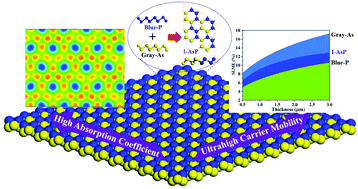Two-dimensional Blue-AsP monolayers with tunable direct band gap and ultrahigh carrier mobility show promising high-performance photovoltaic properties†
Abstract
The successful fabrication of black phosphorene (Black-P) in 2014 and subsequent synthesis of layered black As1−xPx alloys have inspired research into two-dimensional (2D) binary As–P compounds. The very recent success in growing blue phosphorene (Blue-P) further motivated exploration of 2D Blue-AsP materials. Here, using ab initio swarm-intelligence global minimum structure-searching methods, we have obtained a series of novel and energetically favored 2D Blue-AsP (denoted x-AsP, x = I, II, III, IV, V) compounds with As : P = 1 : 1 stoichiometry. They display similar honeycomb structures to Blue-P. Remarkably, the lowest-energy AsP monolayer, namely I-AsP, not only possesses a quasi-direct band gap (2.41 eV), which can be tuned to a direct and optimal gap for photovoltaic applications by in-plane strain, but also has an ultrahigh electronic mobility up to ∼7.4 × 104 cm2 V−1 s−1, far surpassing that of Blue-P, and also exhibits high absorption coefficients (×105 cm−1). Our simulations also show that 30 nm-thick I-AsP sheet-based cells have photovoltaic efficiency as high as ∼12%, and the I-AsP/CdSe heterostructure solar cells possess a power conversion efficiency as high as ∼13%. All these outstanding characteristics suggest the I-AsP sheet as a promising material for high-efficiency solar cells.



 Please wait while we load your content...
Please wait while we load your content...